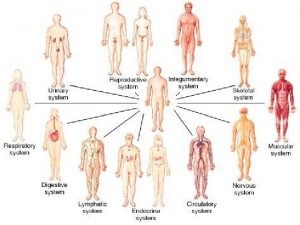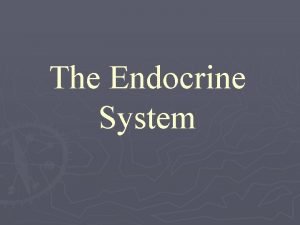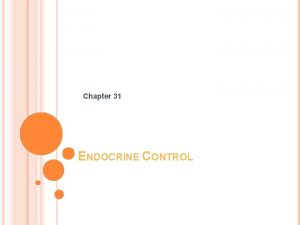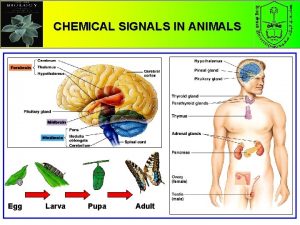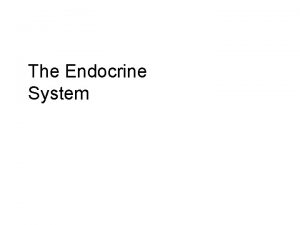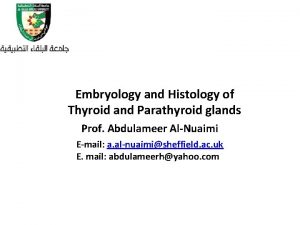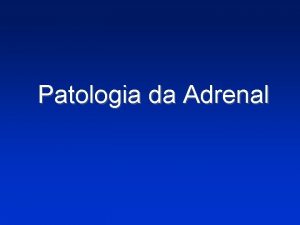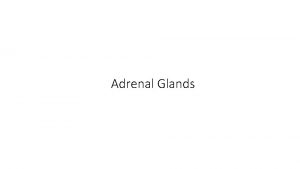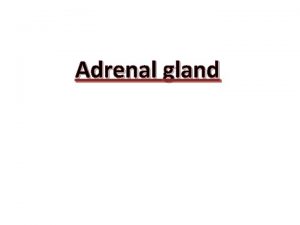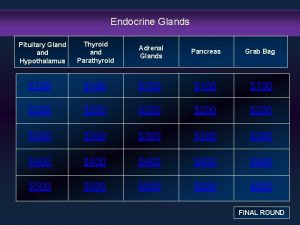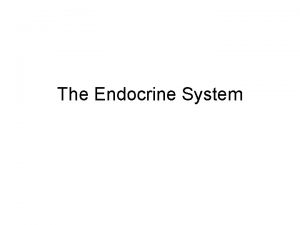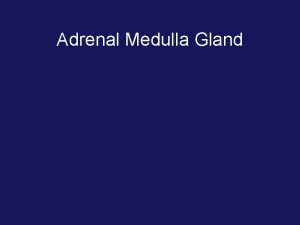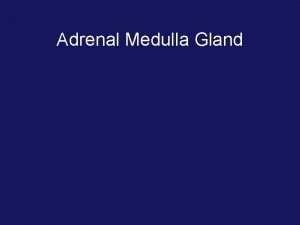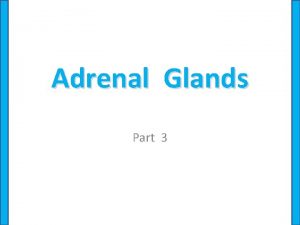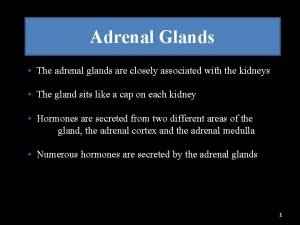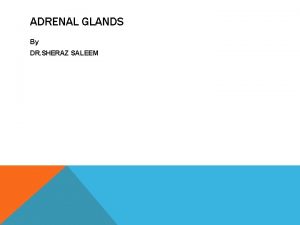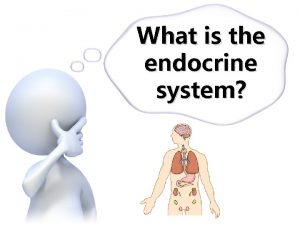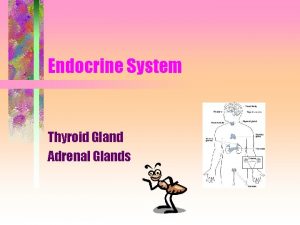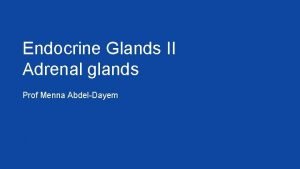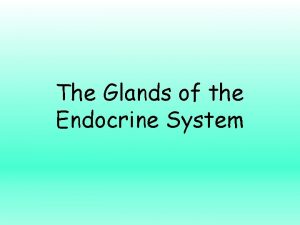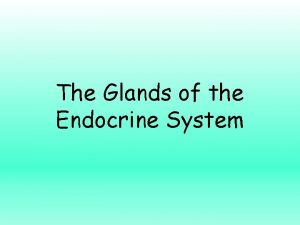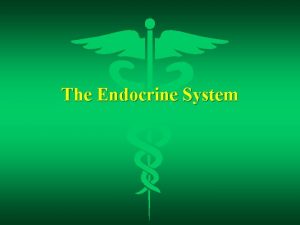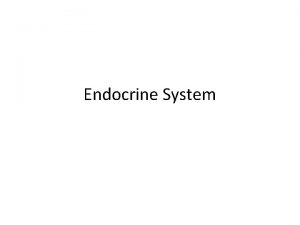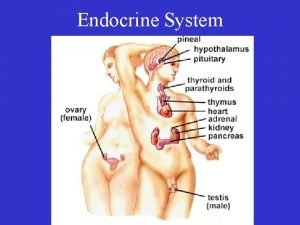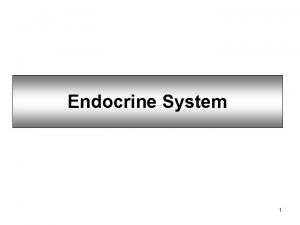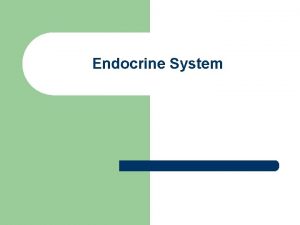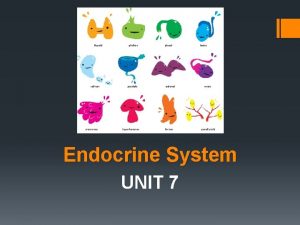What is the endocrine system thyroid adrenal glands

























- Slides: 25

What is the endocrine system?

thyroid adrenal glands testes (males) pituitary gland pancreas ovaries (females)


controls growth; stimulates other glands like thyroid, ovaries and testes controls metabolic rate prepares the body for stressful situations controls the development of secondary sexual characteristics and the menstrual cycle controls blood glucose lev controls the development of secondary sexual characteristics and the production of sperm


The endocrine system slow response The nervous system rapid response uses chemical messages uses electrical impulses response is long-lived response is short-lived (1 mark per box)

2. A hormone is a chemical message produced in an endocrine gland; which has its effect in a target organ. (2 marks) 3. A hormone travels in the bloodstream. (1 mark) 4. a insulin b adrenal gland c prepares the body for stressful situations d controls the metabolic rate of the body (1 mark) 5. FSH acts on the ovaries in females. It stimulates the development of the egg in the ovary. FSH acts on the testes in males. It stimulates sperm production by the testes. (4 marks)

Glucoregulation Glucose is a type of sugar used by the body to provide energy. l Eating causes blood glucose levels to rise. l Vigorous exercise causes blood glucose levels to fall.

Blood glucose levels are monitored and controlled by the pancreas The pancreas produces and releases different hormones depending on the blood glucose level. l Insulin is released when blood glucose levels are high – the liver stores excess glucose as glycogen. l Glucagon is released when blood glucose levels are low – the liver converts stored glycogen into glucose and releases it into the blood.


Activity Work out the keyword for each of the given definitions Keyword Definition A hormone made by the pancreas that tells your liver to change glycogen back into glucose. A hormone (chemical messenger) it tells your body to change glucose into glycogen. It is made by the pancreas. A storage substance made of glucose, it is stored in the liver. A sugar used in respiration to make energy


https: //www. youtube. com/watch? v=X 78 C 5 ajm. KJs Insulin produced by the _____ causes _______to change to ____. Glucose rises (eat food) Normal blood glucose level. Glucoregulation Negative feedback loop Glucose falls (exercise) ____ released and _____ converted back to glucose Normal blood glucose level.


Research task We are working on these scientific skills: • Researching: Information gathering, selecting valid sources of information • Note taking (concise) • Collating and making sense of information gathered

Type 1 diabetes is caused by the pancreas not producing enough insulin and can be controlled by injections of insulin into the body (usually through subcutaneous fat) In Type 1 diabetes people are born with it and the level of physical activity and diet affects the amount of insulin required through injection Type 2 diabetes is acquired (lifestyle risk factors- being over weight) and is caused by a person becoming resistant to insulin. Type 2 can be controlled by diet and physical activity


Answers

Answers Grade Percentage % 9 90 8 80 7 70 6 60 5 50 4 40 u Below 40

Negative feedback loop

Thyroxine The thyroid gland in your neck uses iodine from your diet to produce a hormone called thyroxine. Thyroxine controls your metabolic rate (remember all the examples of metabolic reactions- e. g. how quickly substances are broken down and built up, respiratory rate etc. ) Thyroxine plays an important part in growth and development. In adults the level of thyroxine remains stable as a result of negative feedback

Thyroxine negative feedback If the levels of thyroxine in the blood begin to fall, it is detected by receptors in the brain. As a result, the amount of TSH released from the pituitary gland increases. TSH stimulates the production of thyroxine by the thyroid gland. As the level of thyroxine goes up, in turn the level of TSH released falls.

Adrenaline Your adrenal glands secrete adrenaline when you are stressed. Adrenaline prepares your body for flight or fight. It boost the delivery of oxygen and glucose to your brain and muscles. It is not controlled by negative feedback. Once the stress is over, adrenaline stops being secreted.

Change occurring in the body How this change helps us deal with a stressful situation Increases heart rate To circulate blood to vital organs. This will take oxygen and glucose to the muscles faster, to release energy to run or fight. Increases breathing rate To increase ventilation rate. This will increase the uptake of oxygen, and remove carbon dioxide. This allows us to release energy faster to run or fight. Stored glycogen in the The glucose is taken to the muscles and used in respiration to liver is converted to release more energy for movement. glucose and released into the blood Pupils dilate This allows more light to enter the eye, improving vision. More oxygen and glucose Increases mental awareness. This helps us to think faster and goes to the brain respond quicker. Blood is diverted away Digestion is stopped as it is not important during stress. The from the digestive system skeletal muscles have a better supply of blood to run or fight. to the big skeletal muscles

Answers a. adrenal glands (1 mark) b. just above the kidney (1 mark) c. endocrine gland (1 mark) d. in the bloodstream (1 mark) e. target organs are those that the hormone acts on, causing a response (1 mark)
 Glands of the endocrine system
Glands of the endocrine system Adrenal glands
Adrenal glands Organ systems
Organ systems Holocrine
Holocrine Major endocrine glands male and female
Major endocrine glands male and female Chapter 16 matching question 6-10
Chapter 16 matching question 6-10 Difference between endocrine and exocrine glands
Difference between endocrine and exocrine glands Are endocrine glands ductless
Are endocrine glands ductless Histology thyroid gland
Histology thyroid gland Whats the difference between endocrine and exocrine glands
Whats the difference between endocrine and exocrine glands Hypothal
Hypothal Endocrine glands
Endocrine glands What are chemical signals
What are chemical signals Endocrine glands
Endocrine glands Endocrine glands
Endocrine glands Rhinarium
Rhinarium Thyrooid
Thyrooid Histological structure of parathyroid gland
Histological structure of parathyroid gland Endocrine system and reproductive system
Endocrine system and reproductive system Endocrine system vs nervous system
Endocrine system vs nervous system Lymphatic system vs endocrine system
Lymphatic system vs endocrine system Nervous system vs endocrine system venn diagram
Nervous system vs endocrine system venn diagram Adh function
Adh function Adrenal gland sympathetic nervous system
Adrenal gland sympathetic nervous system Thyroid
Thyroid Cutaneous membrane
Cutaneous membrane


